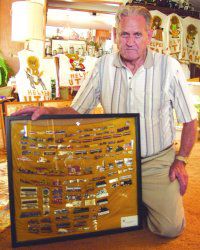| Harold “Pudge” Nielsen sits with one of his many cases of pins he has collected over the years as a member of the lions club. |
Harold “Pudge” Nielsen began life up Spring Canyon as a miner’s son. As a boy, his father’s friends, Italian immigrant miners, began calling him “Pudgimean” (spelling this correctly is optional).
“I have no idea why they called me that,” says the lifelong Helper resident. “And I have no idea what it means. But that’s how I became known as Pudge.”
He is well known in the community for a number of things. His long service as an engineer for Rio Grande Railroad and his 35 years as a volunteer fire fighter for the Helper Fire Department.
He is also known for his dedication to the Helper Lions Club which ties right in with his huge pin collection.
“I joined the Lions Club in 1953 and began getting pins right away,” he says as he points to the cases and cases of Lions pins spread all over his living room floor. “I just kept them and for the last 48 years I have been collecting them.”
The Lions Clubs in every state design a new pin each year. Internationally, Lions Clubs also produce various pins, and Pudge has almost all of them.
“The only one I haven’t been able to get ahold of is the Russian Lions Club pin,” he states as he proudly shows off a book of pins he has put together. “They began their clubs only a few years ago and I haven’t been able to get one of those.”
Trading pins at national and international Lions Club conventions is one of the activities many of the club members do that attend.
“I’ve been lucky,” he says. “As I have collected the 4800 pins I presently have I have also had the chance to travel.”
Pudge says the Lions Club conventions have taken him to a number of foreign countries as well as all over the United States and Canada.
“The conventions aren’t quite what they used to be,” he states. “I remember years ago going to conventions that had 60,000 people attending them. The last one I went to had around 26,000.”
The Lions Clubs are service organizations, and Pudge still believes in that creed. Some of the pins he owns have increased greatly in value since he either traded for them or purchased them.
“At conventions the trading of pins is a big deal,” he states. “But in other places I was able to buy a lot of these for 60 or 80 cents each. Today some of the old pins you see are now worth $300-400. I do sell some when people want to pay the price. But I ask them to make out the check to the Lions Eye Bank.”
The Lion’s Eye Bank is a non-profit fund that helps people who need vision help. People donate not only money to the bank, but even their eyes as organ donors when they die.
Another interesting part of Pudge’s collection is the vests that he has; they go hand in hand, or to be exact, pin to pin, with his badge collection. He has 16 of them, womens and mens. They say Helper Utah on the back of them. They also have various lions sewn on them, for the various conventions they were taken to. For instance, for the Hawaiian convention there is a lion with a hula skirt on. One lion is carrying a saxophone, probably for New Orleans.
“The club made these vests so people would know where we were from,” says Pudge. “When they first saw Helper, Utah on the back they thought that it was just our club saying that we helped Utah, but then they began to realize it was where we were from. They were a big hit and soon everyone was looking for us at each convention.”
The pins that Pudge has denote many different things from states to cities, to trains and animals. Some are airplanes and others automobiles. But each has a memory for him and he still continues to collect them to this day.
“I don’t know how much I have put into these over the years, but it doesn’t matter,” he states. “I have enjoyed collecting them.”
And they have probably enjoyed his company as well.

